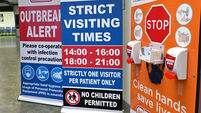Factory staff wary of water after uranium found in local supply
“About a month ago everybody here was complaining about the taste of the tea in the canteen,” Michael Patterson, who works at the local Wampher facility, said yesterday.
“For about a week nobody would drink the tea or the coffee, because the water was absolutely dreadful. All they’d drink was bottled water or milk,” Michael, a father of three young children, recalled.













